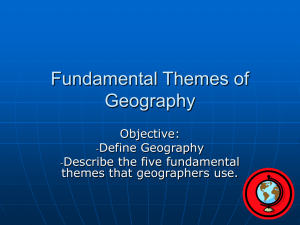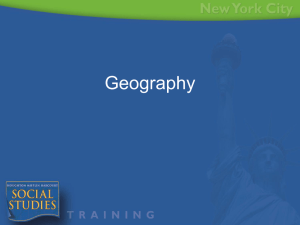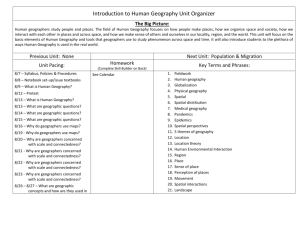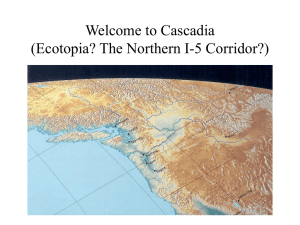Why Geography Matters: Three Challenges Facing America. Climate
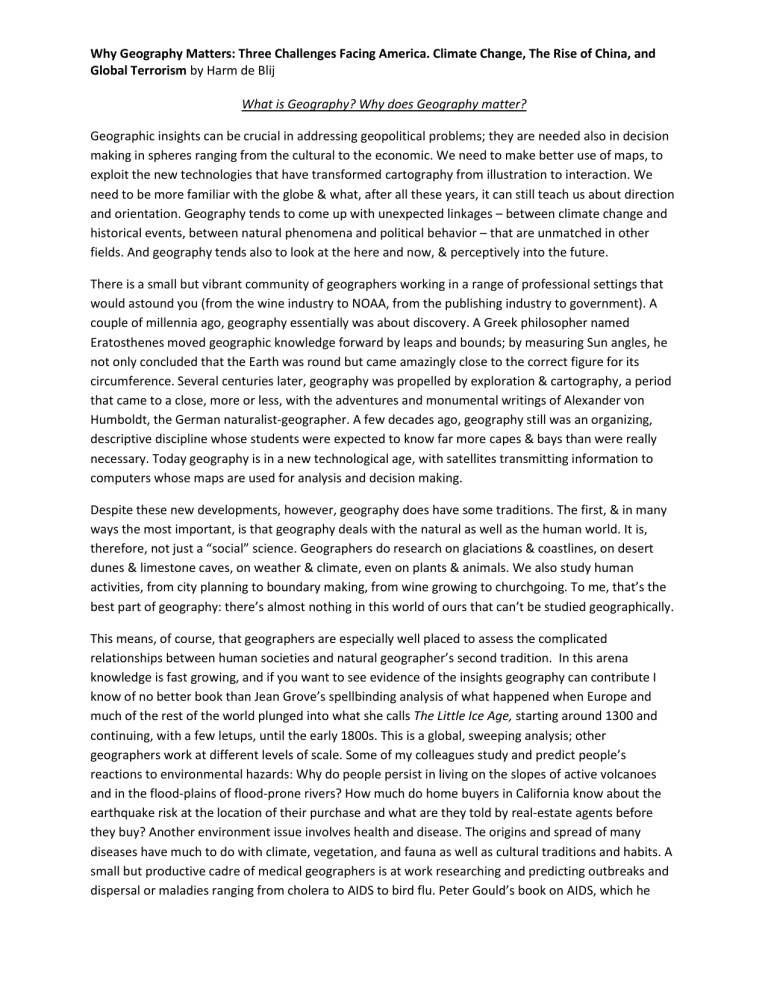
Why Geography Matters: Three Challenges Facing America. Climate Change, The Rise of China, and
Global Terrorism by Harm de Blij
What is Geography? Why does Geography matter?
Geographic insights can be crucial in addressing geopolitical problems; they are needed also in decision making in spheres ranging from the cultural to the economic. We need to make better use of maps, to exploit the new technologies that have transformed cartography from illustration to interaction. We need to be more familiar with the globe & what, after all these years, it can still teach us about direction and orientation. Geography tends to come up with unexpected linkages – between climate change and historical events, between natural phenomena and political behavior – that are unmatched in other fields. And geography tends also to look at the here and now, & perceptively into the future.
There is a small but vibrant community of geographers working in a range of professional settings that would astound you (from the wine industry to NOAA, from the publishing industry to government). A couple of millennia ago, geography essentially was about discovery. A Greek philosopher named
Eratosthenes moved geographic knowledge forward by leaps and bounds; by measuring Sun angles, he not only concluded that the Earth was round but came amazingly close to the correct figure for its circumference. Several centuries later, geography was propelled by exploration & cartography, a period that came to a close, more or less, with the adventures and monumental writings of Alexander von
Humboldt, the German naturalist-geographer. A few decades ago, geography still was an organizing, descriptive discipline whose students were expected to know far more capes & bays than were really necessary. Today geography is in a new technological age, with satellites transmitting information to computers whose maps are used for analysis and decision making.
Despite these new developments, however, geography does have some traditions. The first, & in many ways the most important, is that geography deals with the natural as well as the human world. It is, therefore, not just a “social” science. Geographers do research on glaciations & coastlines, on desert dunes & limestone caves, on weather & climate, even on plants & animals. We also study human activities, from city planning to boundary making, from wine growing to churchgoing. To me, that’s the best part of geography: there’s almost nothing in this world of ours that can’t be studied geographically.
This means, of course, that geographers are especially well placed to assess the complicated relationships between human societies and natural geographer’s second tradition. In this arena knowledge is fast growing, and if you want to see evidence of the insights geography can contribute I know of no better book than Jean Grove’s spellbinding analysis of what happened when Europe and much of the rest of the world plunged into what she calls The Little Ice Age, starting around 1300 and continuing, with a few letups, until the early 1800s. This is a global, sweeping analysis; other geographers work at different levels of scale. Some of my colleagues study and predict people’s reactions to environmental hazards: Why do people persist in living on the slopes of active volcanoes and in the flood-plains of flood-prone rivers? How much do home buyers in California know about the earthquake risk at the location of their purchase and what are they told by real-estate agents before they buy? Another environment issue involves health and disease. The origins and spread of many diseases have much to do with climate, vegetation, and fauna as well as cultural traditions and habits. A small but productive cadre of medical geographers is at work researching and predicting outbreaks and dispersal or maladies ranging from cholera to AIDS to bird flu. Peter Gould’s book on AIDS, which he
Why Geography Matters: Three Challenges Facing America. Climate Change, The Rise of China, and
Global Terrorism by Harm de Blij called The Slow Plague, effectively displays the toolbox of geographers when it comes to such analyses
(Gould, 1993).
A third geographic tradition is simply this: we do research in, and try to understand, foreign cultures and distant regions. A few decades ago, it was rare to find a geographer who did not have some considerable expertise in a foreign language (this used to be a requirement for graduation with a doctorate), kept up with the scholarly literature as well as the popular press in their chosen region, and conducted repeated research there. That tradition has faded somewhat in the new age of the Internet, satellite data, and computer cartography, but many students still are first attracted to geography because it aroused their curiosity about some foreign place. The decline in interest in international affairs is not unique to geography, of course. From analyses of network news content to studies of foreign-area specialization in
United States intelligence operations, our isolationism and parochialism are evident. But there will be a rebound, probably of necessity more than desire. Geographic provincialism entails serious national security risks.
A fourth tradition geographers like to identify is the so-called location tradition, which is essentially a human-geographic (not a physical-geographic) convention. Why are activities, such as movie industries or shopping centers, or towns or cities such as Sarasota, Florida, or Tokyo, Japan located where they are? What does their location imply for their prospects? Why did city thrive and grow while a nearby settlement dwindled and failed? Often a geographic answer illuminates historic events. Urban and regional planning is now a key component to many college geography curricula, and many of our graduates find positions in the planning field. Having said all this, we still don’t have a short-answer definition of geography.
To pull it all together, we need a word that telegraphs our main geographic preoccupation, and that word derives from space – not celestial space, but Earthly space. We geographers look at the world
spatially. I sometimes try this concept on a questioner: historians look at the world temporally or chronologically; economists and political scientists come at it structurally, but we geographers look at it spatially. Geography is a discipline of diversity, under whose “spatial” umbrella we study and analyze processes, systems, behaviors, and countless other phenomena that have spatial expression. It is this tie that binds geographers, this interest in patterns, distributions, diffusions, circulations, interactions, juxtapositions – the ways in which the physical and human worlds are laid out, interconnect, and interact. So geography’s umbrella is large, allowing geographers to pursue widely varying research.
These days that includes a lot of social activism and other work that might seem closer to sociology than to geography, but much geographic research remains spatial and substantive. I have colleagues whose work focuses on Amazonian deforestation, West African deforestation, Asian economic integration,
Indonesian transmigration. Others take a more specific look at such American phenomena as professional football and the sources and team destinations of players, the changing patterns of church membership and evangelism, the rise of the wine industry in this period of global warming, and the impact of NAFTA on manufacturing employment in the Midwest. I’m always fascinated to read in our professional journals what they’re discovering, and as I used to tell my students, the Age of Discovery may be over, but the era of geographic discovery never will be.



